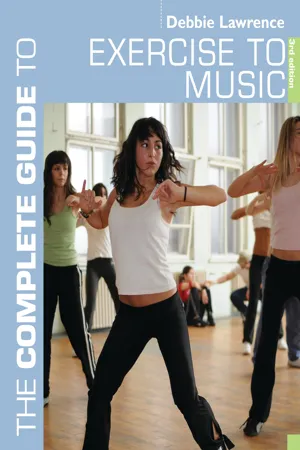![]()
![]()
WHY EXERCISE TO MUSIC?
Exercise to music is simply any exercise programme that is planned and structured to work to the beat and phrase and structure of the music. It includes sessions planned to
music with minimal choreography, and also highly choreographed dance-style classes. Over the last three decades a number of variations and approaches have presented, these include: hi/lo aerobics;
step; slide; body conditioning; legs, bums and tums; group resistance training; hard core conditioning; stretch and tone; mind and body; street dance; salsa; the Body Training Systems™
– Body Jam, Body Combat, Body Pump, Body Balance.
![]()
THE BENEFITS OF EXERCISE TO MUSIC | | 1 |
After completing this chapter you will be able to:
• Name and describe the components of physical fitness.
• Explain some of the benefits of improving each component of physical fitness.
• Recognise the American College of Sports Medicine (ACSM, 2006) training guidelines for improving each component of physical fitness.
• Identify appropriate activities that may be included within an ETM session to improve physical fitness.
• Name and describe the components of total fitness.
• Recognise the contribution of ETM as a training mode for improving total fitness/health.
What are the general benefits of exercise to music?
Exercise to music (ETM) is a safe and effective method of exercising that is enjoyed by a variety of people. A well-designed ETM programme can improve all the components of fitness that contribute to the physical fitness of an individual. The most essential components for maintaining our fitness for life (health-related fitness), and fitness to participate in sporting activities are: cardiovascular fitness, muscular strength, muscular endurance, flexibility and motor fitness. Sportspeople need more focused training in the specific skill-related components known as motor fitness. These skill-related components include: agility, balance, reaction time, speed, power and coordination.
Being physically fit also contributes to our overall health, or total fitness. Total fitness includes social, mental, emotional, nutritional, spiritual and medical fitness. This chapter explores and discusses each of the components of physical and total fitness. It also identifies how ETM can improve our physical fitness and lead to total fitness.
The five components of physical fitness
1 Cardiovascular fitness
2 Muscular strength
3 Muscular endurance
4 Flexibility
5 Motor fitness.
What is cardiovascular fitness?
Cardiovascular fitness is the ability of the heart, lungs and circulatory/vascular system to take in, transport and utilise oxygen efficiently. It is sometimes referred to as cardio-respiratory fitness, stamina, or aerobic fitness.
Why do we need cardiovascular fitness?
A strong heart and efficient respiratory and circulatory systems are essential for maintaining our quality of life; they are also essential to enable us to participate safely in sporting and recreational activities. A weak heart and inefficient respiratory and circulatory systems are more susceptible to diseases that cause premature death. Indeed, coronary heart disease (CHD) is the highest cause of death in the Western world. Increased physical activity and improved cardiovascular fitness can help prevent cardiovascular diseases and reduce the risk factors that contribute to the onset of CHD (high blood pressure, obesity, diabetes etc).
In the long term, specific training to improve cardiovascular fitness will improve the efficiency of the heart, lungs and blood vessels. The heart (cardiac muscle) becomes stronger, allowing it to pump a greater volume of blood in each contraction (stroke volume); the capillary network in our muscles expands, allowing the transportation of more oxygen to the body cells and the swifter removal of waste products (carbon dioxide and lactic acid); the size and number of mitochondria (the cells in which aerobic energy is produced) increase, which, in turn, enables us to deliver and utilise the oxygen that our muscles receive more effectively. Since oxygen is essential for our long-term production of energy, our ability to perform aerobic activities will improve. This will enable us to perform such activities for a longer period of time.
Activities which make demands on the cardiovascular system increase the metabolic rate, i.e. the rate at which we use energy or burn calories. Therefore, frequent performance of these activities will assist with the reduction of body fat and the lowering of cholesterol levels, which will assist with effective weight management. The increased strength and efficiency of the cardiovascular system, coupled with the reduction in body fat and cholesterol levels may also potentially contribute to the normalising of elevated blood pressure, all of which have a positive effect on our health and help to reduce the risk of CHD.
Summary of the long-term benefits of cardiovascular training
• Stronger heart/cardiac muscle.
• Increased stroke volume (a larger volume of blood pumped in each contraction of the heart).
• Increased capillarisation (more blood vessels delivering blood and oxygen to the muscles).
• Increased size and number of mitochrondria (cells in which energy is produced with oxygen – aerobic energy production).
• Increased metabolic rate (the rate at which we burn calories is higher during and after exercise).
• Decreased body fat (reduced risk of obesity).
• Improved ratio of cholesterol (increased ratio of healthy cholesterol – high density lipo-protein (HDL) which help to remove plaque from artery walls and reduced ratio of low density lipo-protein (LDL) which sticks against artery walls).
• Normalised blood pressure.
• Decreased risk of coronary heart disease.
How can we improve our cardiovascular fitness?
To improve the fitness of the heart, respiratory and circulatory system we need to perform rhythmic activities which use the larger muscles (legs and buttocks) of the body. The ACSM (2006) recommendation is that these activities should be performed on a regular basis, ideally between three to five times per week, and at a moderate intensity to create a feeling of mild breathlessness, without any unnecessary discomfort; we should be able to sustain these activities comfortably for a prolonged duration. Traditional activities that promote this type of fitness are walking, running, cycling, aerobic dancing, rowing, swimming, stair climbing and using cardiovascular machines. Adherence to this type of exercise programme will induce the necessary long-term health-related improvements to the cardiovascular system. The recommended training requirements for improving cardiovascular fitness are outlined in table 1.1.
| Table 1.1 | The recommended training requirements for improving cardiovascular fitness |
| Frequency How often? | 3–5 times a week (decrease frequency when working at higher intensity). |
| Intensity How hard? | Between 55% to 90% maximal heart rate (MHR) with different target heart rate zones being used to indicate the working level for different training goals and individual fitness. Equivalent to RPE 12–16 (somewhat hard to hard). (NB: Exercise intensity is explored further in chapter 6.) 50–60% of (MHR) for improving health of untrained individuals. 60–70% of MHR for assisting weight management. (NB: Lower intensity can be sustained for longer ... |





